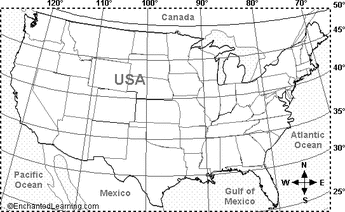 Vernalization Many hop growers are asking this question as the abnormally mild weather persists across much of the USA. For most growers in northern latitudes; probably not much effect will be noted. Average hop vernalization temperature requirements of 6 weeks below 38 degrees Fahrenheit will still be met, resulting in normal burr and cone development later in the season. Expect an earlier emergence of pests and disease that the milder winter failed to kill. For growers in more southern latitudes the story could be completely different. Effects on the hops in the southern tier could include: lack of proper vernalization, increased pest pressure, and increased prevalence and severity of hop diseases like downy and powdery mildews. Hop vernalization requirements vary by hop genotype and varieties that require longer chilling periods may not properly reset back to the juvenile spring phase required to grow and produce a normal yield of cones. One of the first signs of incomplete vernalization is uneven spring emergence of new shoots within plants of the same hop variety. Growers in the PNW have noted that this uneven emergence follows through the entire growing season; affecting cone-set, yield, alphas, and maturity dates. The cone-bearing sidearms may not extend properly and only produce cones on the terminal ends. Many affected hop plants showed up to a 6 week delay of burr initiation and a 30 to 50% loss in total potential yield. It's All About Balance Fertile soil is a mixture of well-balanced minerals, high organic matter, humus, humic, fulvic and carbonic acids, good aeration and bountiful microbial life. The biology or life in the soil is at its healthiest when the nutrients are plentiful and balanced, and there is sufficient oxygen and water. The top soil region is the most vital portion of the soil profile; holding about 70% of the life and 70% of the organic matter. In a typical soil, below 6 inches plant roots are feeding on mostly soluble nutrients since the micro-organisms are not able to thrive due to insufficient oxygen levels. Many minerals are tightly bound to the subsoil colloidal particles are only made available to plants through complex soil interactions with organic acids leaching downward from the topsoil. It is critical to maintain the organic matter content in soils for them to remain balanced and healthy. Download as PDF No doubt about it, for many new growers hops are a difficult crop to grow well. Fast growing hop plants require lots of balanced nutrients and water with critical timing of applications; making hops a real challenge to keep up with when compared to most other crops. Getting the hops to climb to the top trellis wire and produce fully developed side arms with lots of cones seems to be an unattainable goal sometimes. There always seems to be a guy named Murphy lurking around, ready to throw a wrench in the works; despite a hop grower’s best efforts. Wind, rain, drought, and pestilence... yet there are lots of pretty pictures of hopyards and recorded harvest yields to show it is more than a dream. It is common to find in many instances, less experienced hop growers do not fully understand many integrated hopyard management practices and how plant nutrient availability and growth is affected. This following discussion covers a few of the issues that have been identified as potentially holding back hop growth and yields. These issues are gleaned from talking to, and working with hundreds of new hop growers and the challenges they have experienced. These observations and field notes are intended to educate and provoke deeper, more in-depth discussions amongst hop growers and grower groups.
Downy mildew (DM) of hops is a major disease that affects many susceptible cultivars of hops. It can severely damage both the hop plant as well as making the cones unsuitable for harvest. This discussion pertains to using post harvest DM controls to help hopyards recover from a season of high downy mildew infection. Many hop growers do not understand the importance of controlling downy mildew in their hop yard after harvest is completed. The fungus and the infection are not as visible as springtime symptoms. Many growers consider the season as finished at harvest and leave the yard unattended going into winter. This is a fundamental mistake in controlling DM in infected hopyards. Downy mildew is active whenever conditions permit – it simply doesn't care if it is springtime, summer, or fall. If green plant tissue, moisture and the right temperatures are present, DM will remain active. Post-harvest fungicide applications and controls can be an effective way to manage downy mildew in yards that have had the disease present and reduce the severity of downy mildew spikes that emerge during the following spring growing season. 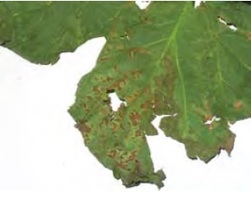 leaf lesions caused by downy mildew. (D. H. Gent) leaf lesions caused by downy mildew. (D. H. Gent) Downy mildew, like most molds and mildews, persists and spreads during the growing season mainly through air-borne spores which infect new leaves and growth whenever environmental conditions are favorable. In the Fall season, however, downy mildew “morphs” into a different creature; producing a specialized motile spore type called a zoospore. This spore acts much more like a living microscopic worm than a fungal spore. The motile zoospore form helps downy mildew complete its annual life cycle by finding a safe resting place for it to overwinter or by forming protective dormant oospores. These forms of DM exist outside of the plant in the soil where it is outside its host and can be interrupted at this point. 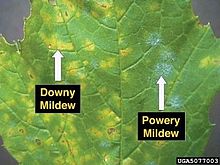 This grower blog deals only with the post-harvest practices in traditional commercial hopyards and some best practice strategies to control and reduce the percentage of overwintering DM and other pathogens. Great Lakes Hops uses these combined practices and has found them to be very effective in the Midwest region hop production. Control of downy mildew (DM) in the hopyard is an ongoing challenge for growers in many regions; and especially difficult for growers that have susceptible hop varieties. DM takes different forms and produces several different spore types in reaction to environmental conditions - i.e. aerial, oospores, and zoospores. Each spore type has its own set of specific control measures. DM is active whenever temperature and moisture conditions are correct; spring, summer, and fall. In the fall season, downy mildew switches from actively producing airborne spores that mainly affect the bines, foliage, and cones; to forming protective oospores and motile zoospores that can overwinter in the soil and dormant hop crown. The more familiar springtime DM spikes on new shoots are less evident in the fall as hop growth slows and the infected older foliage takes on a mottled appearance; which many growers fail to notice. Once DM has a foothold in a hopyard, outside airborne spores are not necessary to re-start early springtime infections. Great Lakes Hops has found the following fall practices to be effective in gaining good control over downy mildew and other pests and pathogens in hopyards. 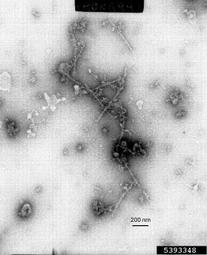 David Gent, USDA Agricultural Research Service, Bugwood.org Carnation Latent Virus (Carlavirus CLV) David Gent, USDA Agricultural Research Service, Bugwood.org Carnation Latent Virus (Carlavirus CLV) New hopyards should carefully select the source of their initial planting stock. Why? Disease causing pathogens naturally accumulate in plants and the maximum crop yield potential falls as time passes over a period years. Many people rationalize this as the plants are “getting old”. Virus and viroids accumulation is an important consideration in long-lived crops like hops. The normal productive years of a commercial hopyard variety that starts with few or no viruses present is about 10 to 12 years before they are typically replaced with new fresh plants. Initial planting stock that is obtained from old hopyards as rhizomes often contain high levels of viruses/viroids. The USDA is aware of this and has a congressional mandate to provide clean seed and planting stock for all commercially important crops. Hops are included in this list and reputable professional propagators source and use this clean nuclear mother stock whenever possible from the USDA source. Great Lakes Hops (GLH) actively searches for, obtains, maintains, and propagates the cleanest nuclear mother stock available (emphasis on AVAILABLE) to us in our specialized MDOA licensed nursery facility. Most of our nuclear mother stock is sourced directly from the USDA National Clean Plant Program / Facility located in the western USA. This is the only current recognized source of hop propagation stock that has been treated and tested for virus removal and is certified With a VF number at the time of its release. We do not propagate or sell hops or rhizomes as a sideline or as non-inspected planting stock. All of our hop transplants are grown specifically for new hop acreage. However, that being said - read carefully and understand the following.
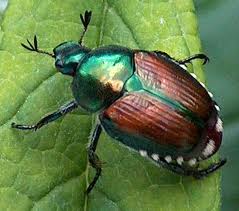 Japanese beetles are proving to be a formidable foe in hop yards located in the Great Lakes region. The beetles can cause significant damage to hop foliage and bines in a very short period of time if left uncontrolled. Two beetles can strip a large hop leaf in a single day and when their numbers reach the thousands, the beetles can strip a hop yard in just a few days. Organic hop growers find controlling them especially frustrating because they cannot apply the synthetic chemical controls commonly utilized. Here are some control strategy tips for all hop growers – organic and non-organic. First concept: Beetles attract more beetles. I do not consider Japanese beetles to be a threshold control-type pest where the decision to spray is based on tolerating a certain level of pests before treatment or spraying is done. Female beetles excrete pheromones to attract males and mating is a gregarious affair – a “beetle orgy” for lack of a better term. Beetles fly into the wind and follow the beetle pheromone trail to the plants and leaves where feeding and mating occur. Females apparently leave pheromones on the leaves; as I note that beetles arrive and continue to congregate on the same leaves – even if the original beetles are removed. However, a good hard rainfall seems to wash away this residual pheromone trail. It is well known that hanging pheromone traps can attract large number of both male and female beetle from great distances. A population of mating beetles will grow exponentially as congregating beetles emit stronger pheromone trails for newcomers to follow to the orgy – just like a pheromone trap. Allowing the beetles to establish a population in a hop yard is exactly like hanging pheromone traps in the middle of your hop yard. Hops are a very chlorine-sensitive crop. Hops varieties such as Cascade, Sorachi Ace, Sterling, Horizon, H. neomexicana and many other aroma hops commonly exhibit chlorine toxicity symptoms in many American soil types if fertilized improperly. Many other varieties of hops may not show clear visual toxicity symptoms but are held back and produce less yield.
The element chlorine is common in nature and exists as an anion (Cl- ). It carries a negative particle charge and competes with other anions such as sulfates and magnesium if it is out of balance to the other elements. It leaches from soils at about the same rate as nitrates. Excess levels of toxic chlorides reduce soil microbe populations and reduce nitrogen conversion rates. Inputs to soils of chlorine are from natural rainfall, irrigation water, and fertilizers (potassium chloride). Swine and poultry manures have relatively high levels of chlorides compared to cattle manures. Chlorine is commonly found at ambient levels of around 50 mg/l in many soils where hops are normally commercially grown. Many cheaper granular formulations of chemical based NPK fertilizers have very high levels of chlorides. (Potassium chloride is a common source.) Chlorine is also considered a micronutrient and helps regulate the osmotic absorption of other nutrients that plants require. It often accumulates in foliar tissues at levels of 2-20 mg/l-1 of dry matter; even though plants require 10 to 100 times less to grow properly. Thus, deficiency symptoms are rare. A level of 180 mg/l in lighter-type soils is considered the upper range for hops production. 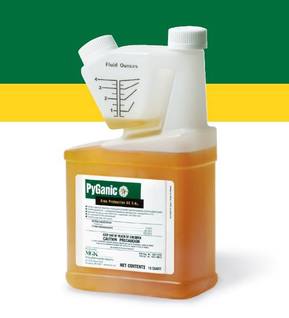 Pyganic insecticide is a very short-lived contact insecticide that is approved for organic use and is OMRI certified. It contains natural pyrethrins derived from chrysanthemum plants and can be sprayed right up to the day of harvest. PyGanic is very useful for quick knock-down of pests such as Japanese beetle adults, mites, aphids, and leafhoppers. It breaks down very quickly when exposed to sunlight. Avoid spraying when bees / pollenators are actively foraging. Hops are not specifically listed on the label. However -"may be used on most crops because its active ingredient is exempt from tolerances when applied to growing crops". Hops fall under the category of Outdoor Grown Crops. Note that PyGanic is a non-selective insectide and will kill beneficials and predator insects as well as the target pest. I would recommended to reserve its use for knockdown when pest levels go out of control. As with all pesticides; read the label carefully before use. |
Details
Blog AuthorLynn, the head hop grower at Great Lakes Hops has over 30 years of experience in the horticultural field. Browse the blog articles here to find useful growing information for humulus lupulus, based on personal experience and observations at Great Lakes Hops. Archives
January 2020
Categories
All
|
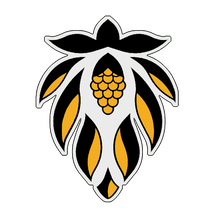
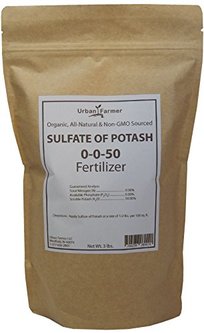

 RSS Feed
RSS Feed